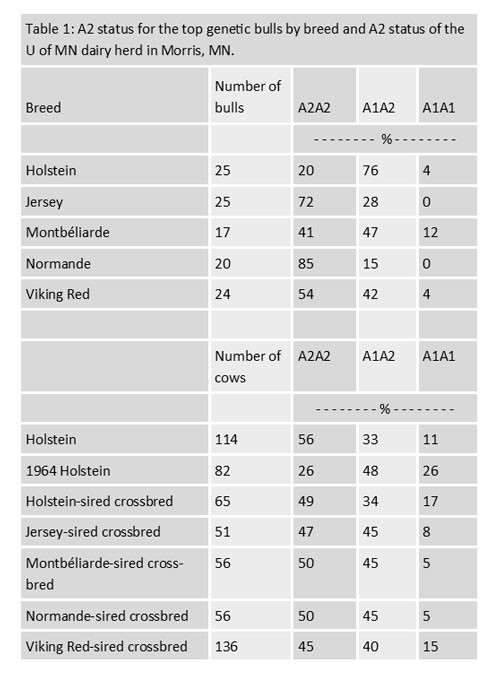By Brad Heins, Associate Professor of Dairy Science, and Glenda Pereira, PhD Animal Science student
May 2019
A2 milk appears to be all of the rage in the dairy industry today. In commercials on TV, online, at the grocery store, and even on the farm, everyone is talking about A2 milk. There are claims that this milk is easier to digest than others, but A2 milk has also been reported to improve health and lower the risk factor for some diseases. Many of these claims have not been proven by science, so let’s dig a little deeper into this A2 phenomenon.
What is A2 milk? Beta-casein, which makes up 30% of milk protein, exists in many forms. The two most common forms are A1 and A2. A2 milk only contains the A2 variant of beta-casein protein, instead of the A1 form. Cows with the A2 gene only produce A2 milk. Jersey, Guernsey, Normande, and Brown Swiss breeds have a higher percentage of A2 genes compared to Holstein.
Some farmers have transitioned to being an A2 herd, but this can take many generations depending on the status of your herd. One way to determine the status of your herd is to test your cows and heifers. If you are already genomic testing, A2 status can be determined for an extra $5 per animal. If you choose to transition to A2, once you receive your genomic results you can determine which cows and heifers to keep or cull. An A2A2 animal, bred to another A2A2 animal will always have an A2 offspring. Cows that are A1A2 or A1A1 will not produce A2 milk. Many A.I. studs have been marketing A2 bulls, and more information can be found online or in published bull catalogs.
The University of Minnesota’s research dairy herd in Morris, uses Holstein, Jersey, Montbéliarde, Normande, and Viking Red in their breeding program. At the top of Table 1 are the A2 status of the Top 25 Net Merit Proven bulls for Holstein and Jersey and the Top Proven Montbéliarde, Normande, and Viking Red bulls available in the US. For the Normande breed, only six bulls have daughters, but the other 14 bulls are genomic only bulls. It comes as no surprise that the Holstein breed has the lowest percentage of A2 bulls in the Top 25 for Net Merit. However, the Jersey and Normande breeds have the highest percentage of A2 bulls.
During the past year, all cows and heifers were genotyped at the University of Minnesota’s research dairy herd in Morris. The A2 status of the cows and heifers in the herd is listed at the bottom of Table 1. You can see that over 50% of the Holsteins in the herd, have A2A2, which was not expected because this trait was not selected for. The 1964 genetic line Holsteins, had a lower percentage of animals that were A2A2 at 26%. Uniquely, the crossbred cows and heifers ranged from 36 to 50% of animals that were A2A2, as expected.

But why should you care about A2 milk? Well, if farmers are being paid a premium for producing A2 milk, then you might consider selecting your herd for A2A2 animals and even start using A2A2 bulls. However, remember that selecting from the top Net Merit bulls is essential to maximize farm profitability, so be sure to check out that list when placing an emphasis on A2 genetics. The future will tell if A2 milk is just a fad or if it will permanently have a seat at the table of the dairy industry.
